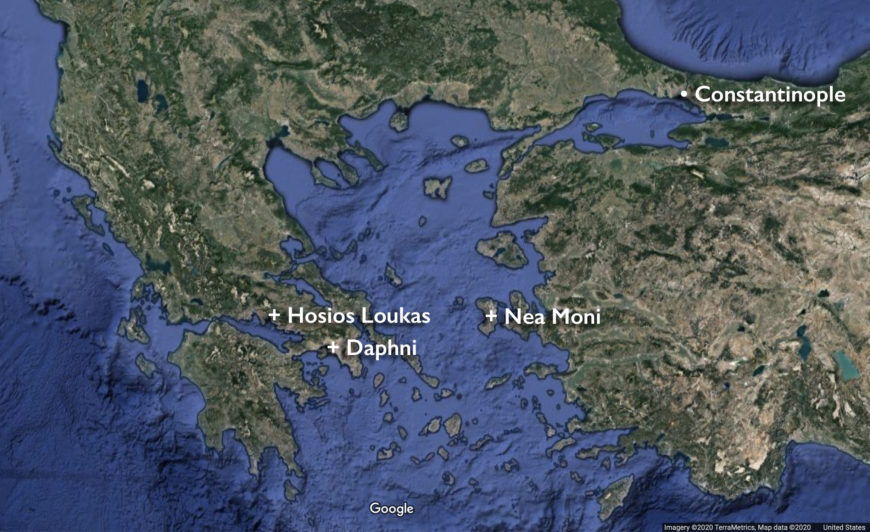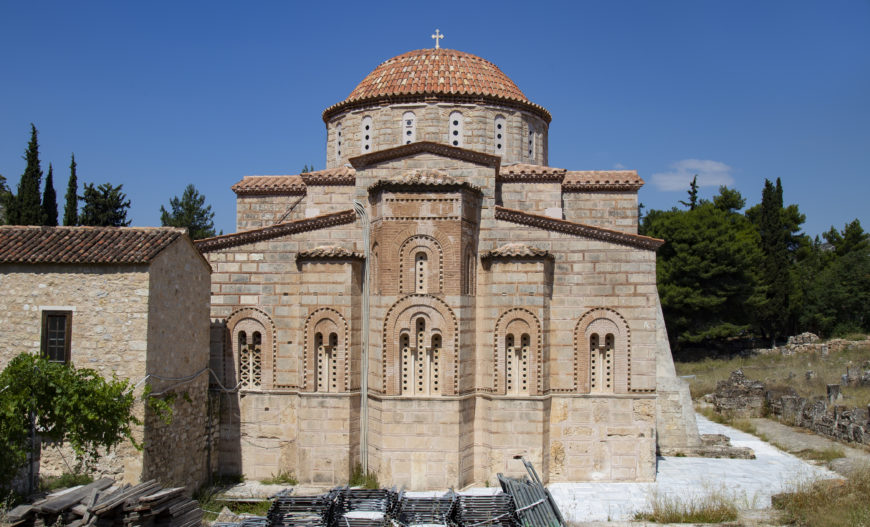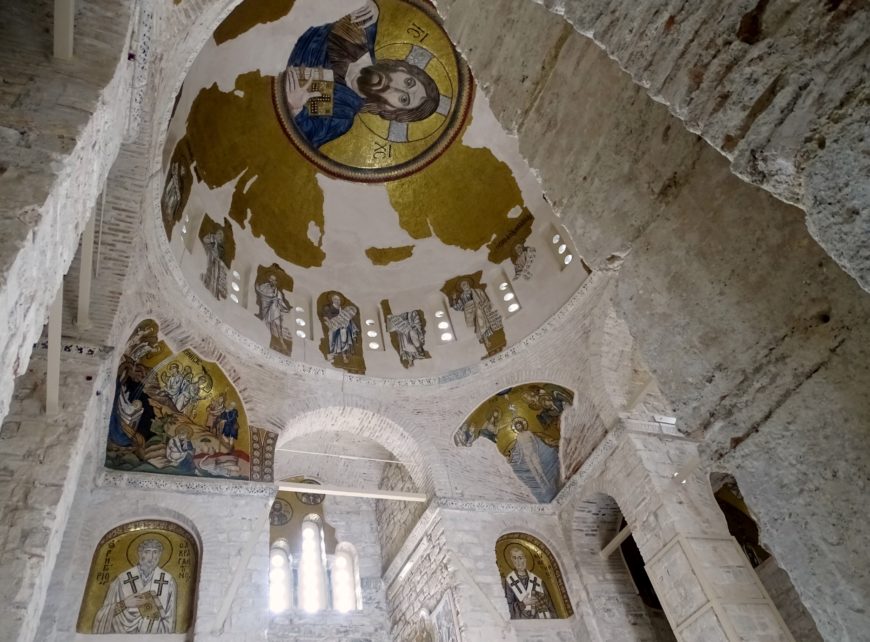
Daphni monastery, Chaidari, c. 1050–1150 (photo: Mark L. Darby, all rights reserved)
Ecstatic Motion
The city of Constantinople, capital of the Eastern Roman (Byzantine) Empire since its foundation by Constantine in 330 C.E., was roiled by the Iconoclastic Controversy in the 8th and 9th centuries. Emperors, bishops, and many others debated whether images, or “icons,” of God and the saints were holy or heretical. Those in favor of images triumphed in 843. Soon after, a new church was built in Constantinople’s great imperial palace and adorned with rich mosaic icons. The church was dedicated to the Virgin of the Pharos, named with the Greek word for a lighthouse, since a lighthouse stood nearby. Around 864, patriarch Photios of Constantinople—the highest-ranking cleric in the empire—gushed about the church of the Pharos and its glittering mosaics: “It is as if one had entered heaven itself . . . and was illuminated by the beauty in all forms shining all around like so many stars, so is one utterly amazed.” Photios describes how his whirling to view the church produced the impression that the church itself was moving:
It seems that everything is in ecstatic motion, and the church itself is circling round. For the spectator, through his whirling about in all directions and being constantly astir, which he is forced to experience by the variegated spectacle on all sides, imagines that his personal condition is transferred to the object. Photios of Constantinople, Homily 10
Photios offers us a tantalizing impression of the Pharos church and a sense of how Byzantines viewed mosaics during this period.
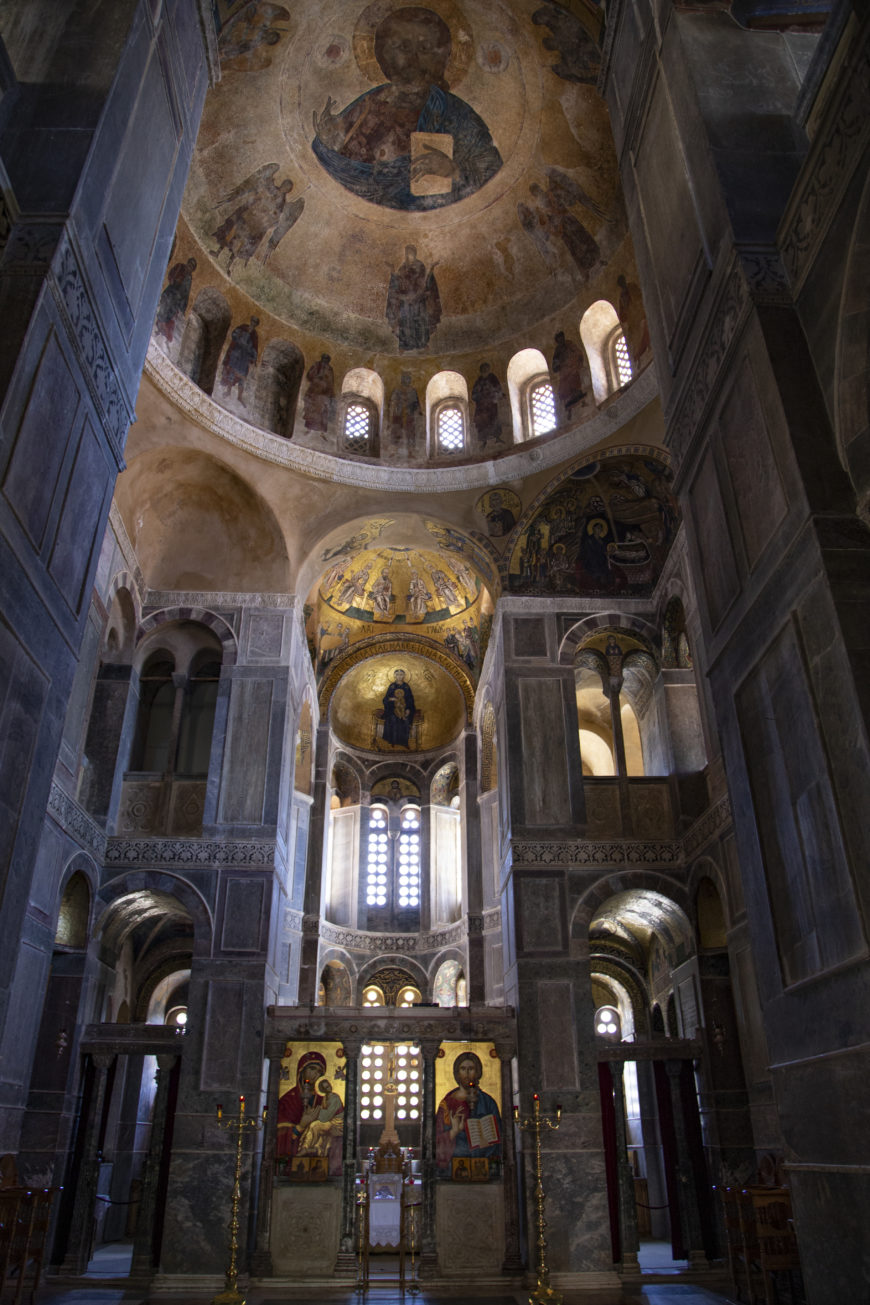
View of the naos, katholikon, 11th century, Hosios Loukas, Boeotia (photo: Evan Freeman, CC BY-SA 4.0)
Middle Byzantine mosaics
While the church of the Pharos has been lost, three churches from around the eleventh century preserve much of their original mosaic programs, which were likely inspired by churches like the church of the Pharos in the capital. These three monuments—Hosios Loukas, Nea Moni, and Daphni—point to common trends in Middle Byzantine mosaics, while also demonstrating the flexibility of church decoration during this period.
Mosaics are patterns or images made of tesserae: small pieces of stone, glass, or other materials. They commonly adorned floors in antiquity but became popular decoration for church walls and ceilings in Byzantium, especially among wealthy patrons such as emperors.
In the Middle Byzantine period (c. 843–1204), domed, centrally planned churches became more popular than the long, hall-like basilicas of previous centuries. While basilicas created a strong horizontal axis between the entrance on one end and the altar at the other, domed churches added a vertical axis that prompted viewers to look upward. New decorative programs developed in tandem with this architectural trend, covering walls and domes with mosaics and frescos of holy figures in complex, new configurations. The lower portions of churches were often decorated with marble revetment (thin panels of marble, often beautifully colored).
Church as microcosm
Byzantine texts interpreted the domed church as a microcosm—a three-dimensional image of the cosmos—associating the sparkling gold vaults above with the heavens, and the colored marbles below with the earth. Within this framework, images often seem to be arranged hierarchically: with a heavenly Christ reigning above, events from sacred history unfolding below, and portraits of saints surrounding the worshippers in the lowest registers. Many of these images took on additional meanings as church services unfolded.
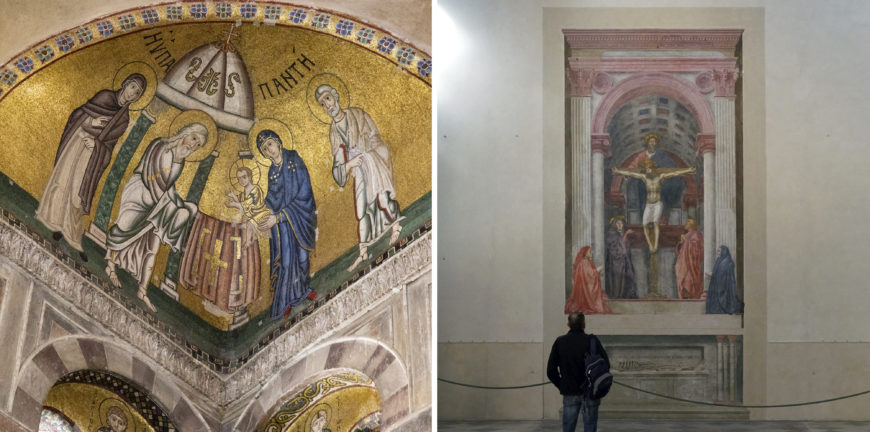
Left: “spatial icon” of the Presentation of Christ in the Temple at Hosios Loukas (photo: Evan Freeman, CC BY-SA 4.0); right: Masaccio’s Holy Trinity fresco at Santa Maria Novella (photo: Steven Zucker, CC BY-NC-SA 2.0)
Spatial icons
The mosaicists who decorated these churches made no effort to create illusionistic backdrops for the holy figures, as one often finds in works from the Italian Renaissance, such as Masaccio’s Holy Trinity fresco. Instead, the holy figures situated in the curves and facets of these Middle Byzantine churches appear against a gold ground. Often, these prophets, saints, and angels seem to face and even communicate with each other across the space of the church. Such “spatial icons”—as the art historian Otto Demus famously described them—created the impression that the holy figures occupied the same physical space as the worshippers.
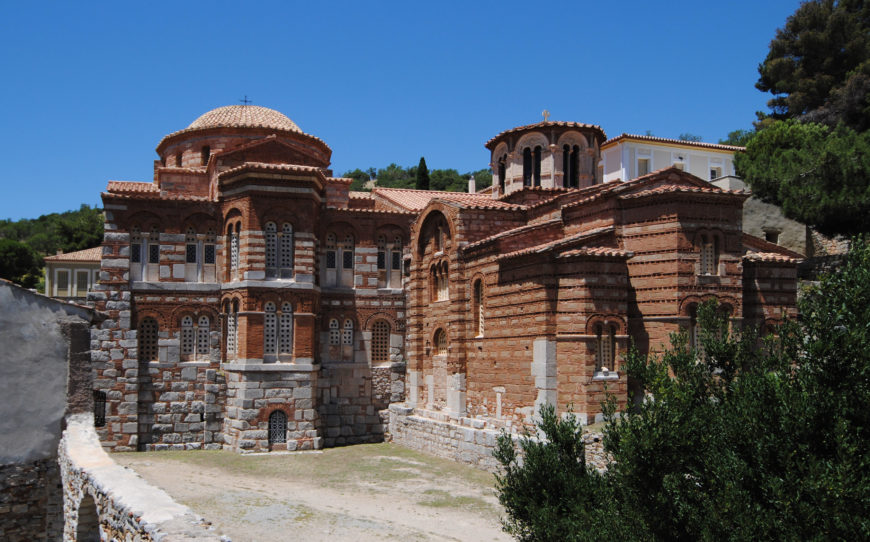
Panagia and katholikon churches seen from the east, 10th and 11th centuries, Hosios Loukas Monastery, Boeotia (© Robert Ousterhout)
Hosios Loukas
The monastery of Hosios Loukas, located in central Greece, is probably the oldest of the three churches. It is named for St. Loukas of Steiris, a local monastic saint who lived on this site and died in 953. Two connected churches survive here. The older church, dedicated to the Virgin and located to the north, features a cross-in-square plan. The katholikon church, built to the south in the eleventh century, utilizes a larger, octagon-domed plan (read more about these church types). The katholikon church retains many of its mosaics, undoubtedly the result of rich patronage. St. Luke’s body was interred between the two churches, and the monastery attracted pilgrims who sought the saint’s healing.
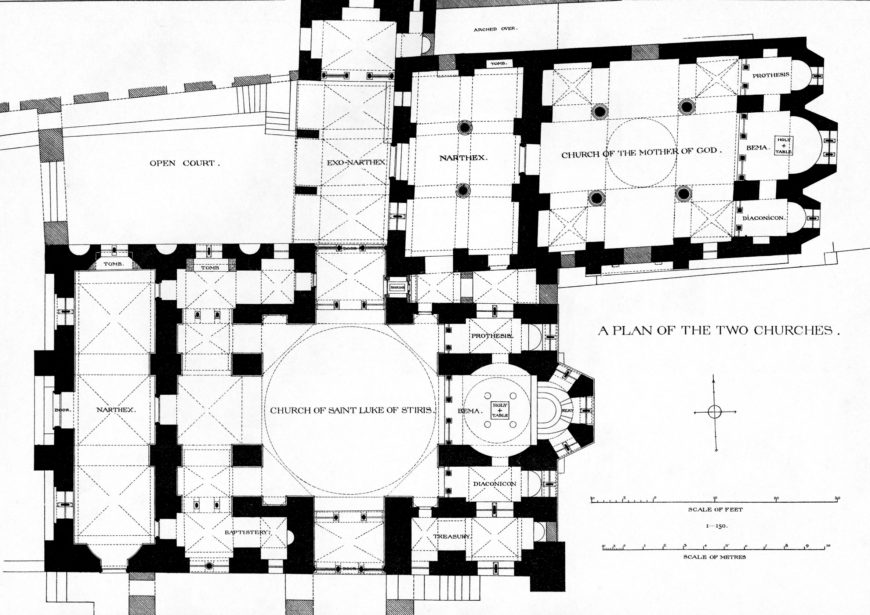
Plan of Hosios Loukas, Greece, 11th century, from Robert Weir Schultz and Sidney Howard Barnsley, The Monastery of Saint Luke of Stiris, in Phocis, and the Dependent monastery of Saint Nicolas in the Fields, near Skripou in Boetia (London: Macmillan, 1901)
Worshippers entered the katholikon through the “narthex,” a vestibule at the western end of the building. Here, they encountered portraits of saints and large images of Christ’s Passion and Resurrection: Christ washing his disciples’ feet, the Crucifixion, the Anastasis, and the incredulous Thomas touching the wounds of the risen Christ.

Narthex mosaics, left: a group of women saints, right: Christ washing his disciples’ feet, katholikon, Hosios Loukas, Boeotia, 11th century (photo: Evan Freeman, CC BY-SA 4.0)
Worshippers then passed beneath a large mosaic of Christ Pantokrator to enter the main part of the church, or “naos.” Christ displays an open book that proclaims him to be the “light of the world” (John 8:12). The mosaic’s gold tesserae reflect sunlight from the front door in the daytime, and flickering candlelight at night.
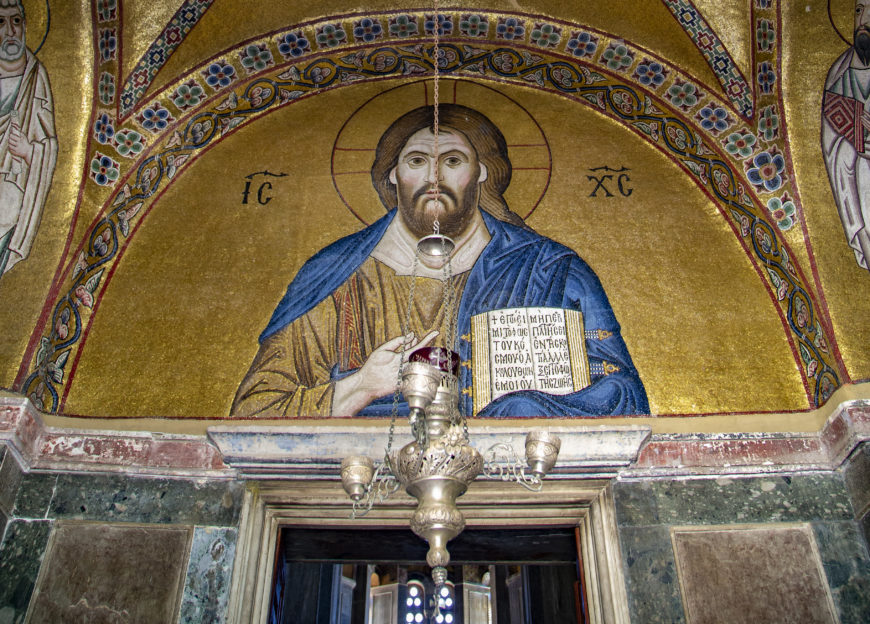
Christ Pantokrater mosaic, narthex, katholikon, Hosios Loukas, 11th century, Boeotia (photo: Evan Freeman, CC BY-SA 4.0)
A large fresco of Christ surrounded by angels occupies the heavenly space of the dome in the naos. This fresco may replicate the original dome mosaics, which have been lost. Four squinches beneath the dome displayed mosaic images from the life of Christ. The Annunciation likely once adorned the northeast squinch but has been lost. The mosaics in the other three squinches depict Christ’s Nativity, Presentation in the Jewish Temple, and Baptism.
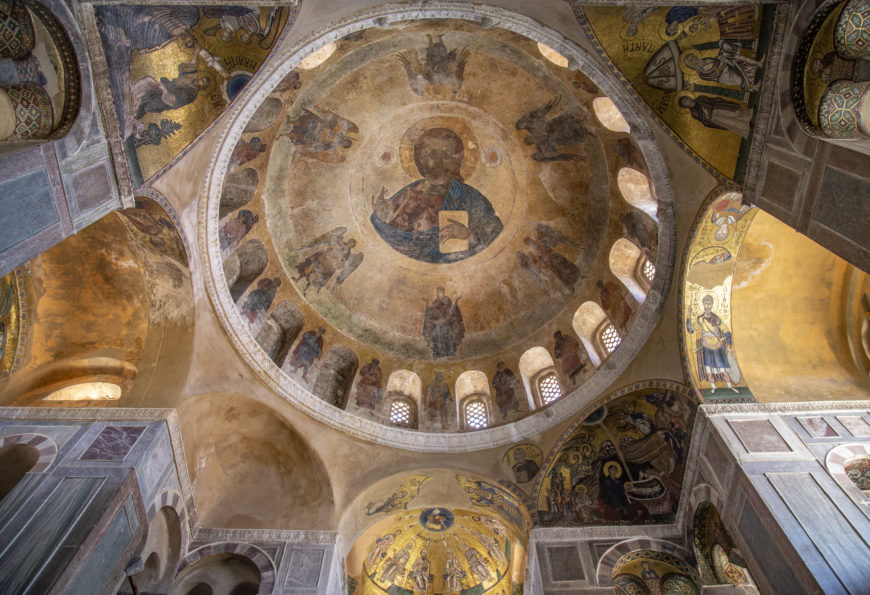
Central dome and squiches, katholikon, Hosios Loukas monastery, Boeotia, 11th century (photo: Evan Freeman, CC BY-SA 4.0)
Various saints appear below. An abundance of monastic saints—including St. Loukas himself—reflects the building’s function as a monastery church.
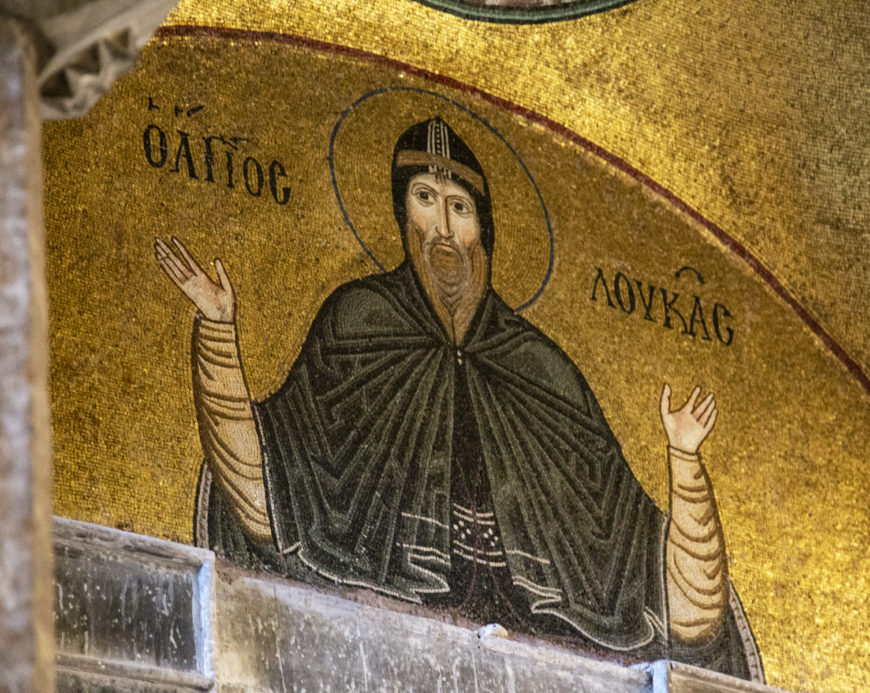
Hosios Loukas (St. Luke of Steiris) mosaic near his tomb, west wall of northern crossarm, katholikon, Hosios Loukas, 11th century, Boeotia (photo: Evan Freeman, CC BY-SA 4.0)
Proceeding through the naos, worshippers saw an image of the descent of the Holy Spirit on the apostles at Pentecost in a smaller dome above the altar. The Virgin and Child sit enthroned in the apse behind the altar, a reminder that God became a human being for the salvation of the world. During the Divine Liturgy, this image of Christ’s incarnation took on new significance as the bread and wine also became the body and blood of Christ.
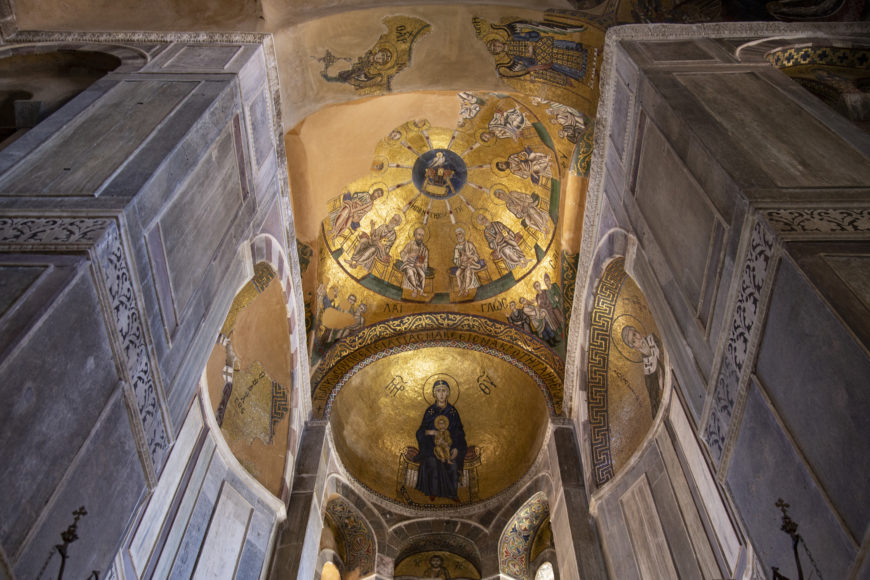
Pentecost, Virgin and Child mosaics, bema, katholikon, Hosios Loukas monastery, Boeotia, 11th century (photo: Evan Freeman, CC BY-SA 4.0)
Nea Moni
Hermit monks founded Nea Moni (“new monastery”) on the island of Chios sometime before 1042, and its katholikon was built with the patronage of emperor Constantine IX Monomachos between 1049–55. It features a rectangular plan, and its architectural design may have been adapted to accommodate its mosaic program.
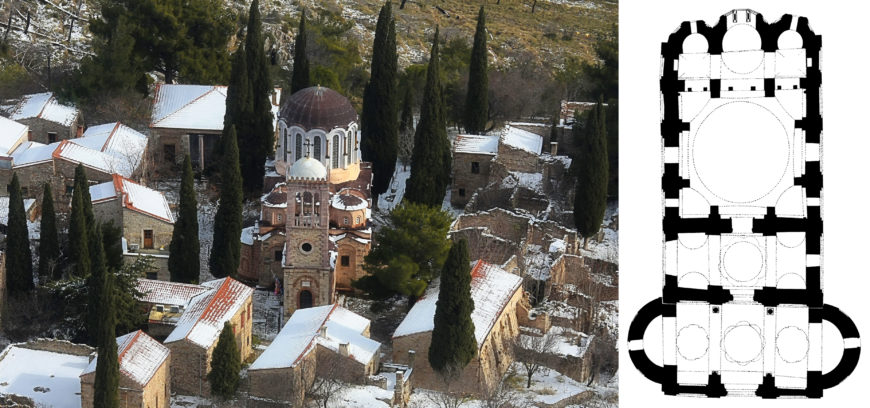
Left: view of Nea Moni from the west (photo: FLIOUKAS, CC BY-SA 4.0); right: Plan of katholikon of Nea Moni, Chios, 11th century (© Robert G. Ousterhout)
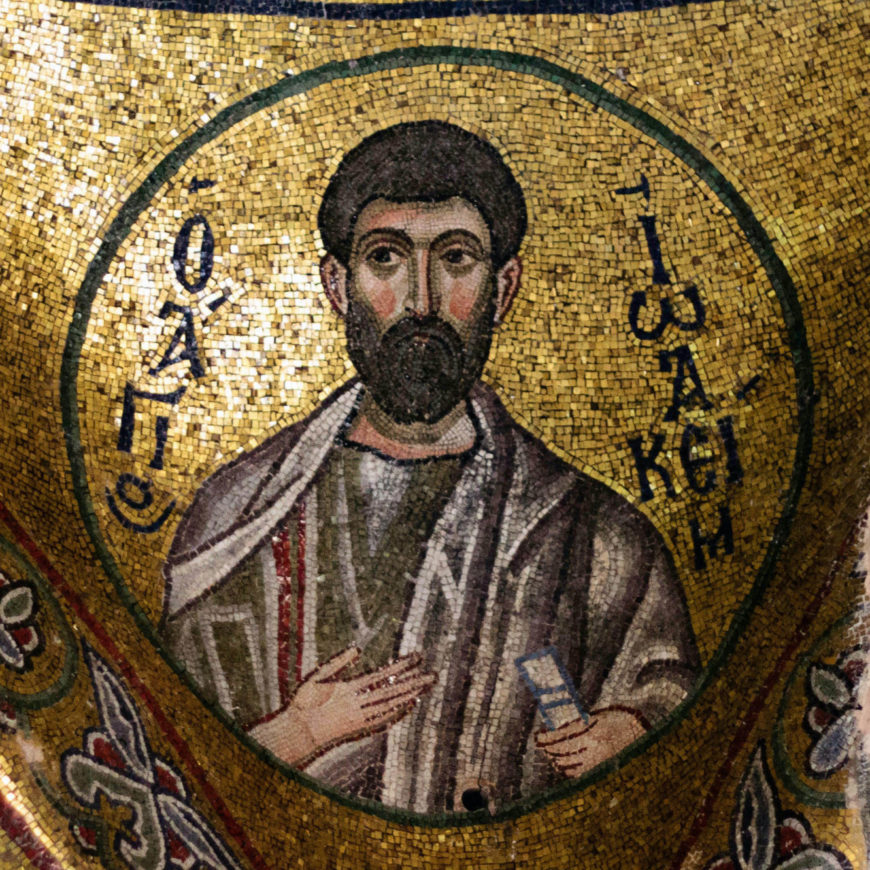
St. Joachim mosaic, 11th century, narthex, katholikon, Nea Moni, Chios (photo: Marmontel, CC BY-SA 2.0)
In the narthex, worshippers again encountered an array of saints and large narrative images centering around Christ’s Passion. In the naos, the main dome has lost its mosaics. But remnants of cherubim and seraphim, evangelists, and apostles inhabit pendentives beneath the dome. Further down, eight alternating conches and niches displayed a ring scenes from the life of Christ. The Virgin appears in the eastern apse behind the altar with hands upraised in prayer, flanked by the archangels Gabriel and Michael.
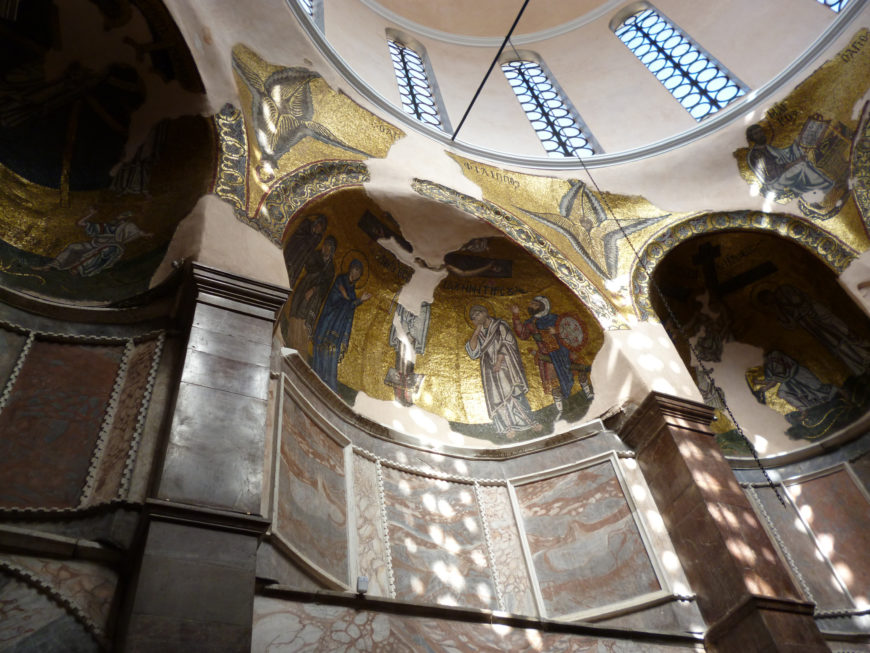
View of the naos, Nea Moni, Chios, 11th century (photo: Meltedrainbow, CC BY-SA 4.0)
Daphni
The monastery of Daphni, located just northwest of Athens, was likely the last of the three churches to be built, probably constructed between 1050–1150. Little is known about the foundation of this cross-in-square church.
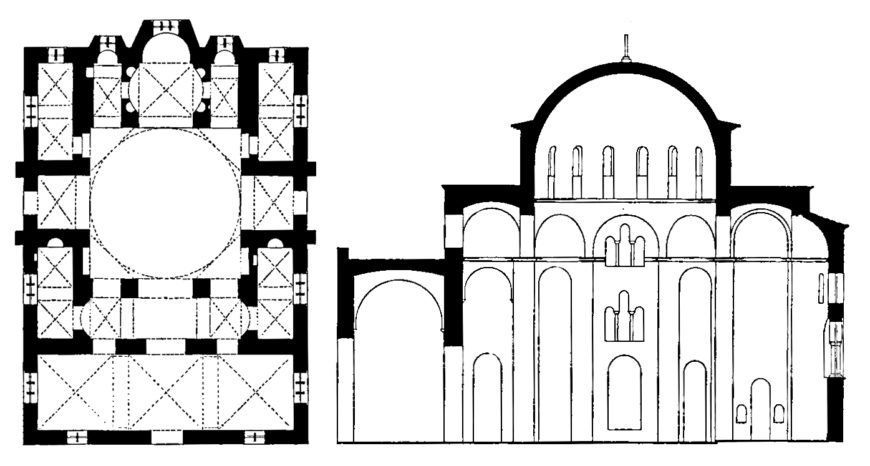
Plan and elevation of Daphni monastery, Chaidari, c. 1050–1150, from Robert Weir Schultz and Sidney Howard Barnsley, The Monastery of Saint Luke of Stiris, in Phocis, and the Dependent monastery of Saint Nicolas in the Fields, near Skripou in Boetia (London: Macmillan, 1901)
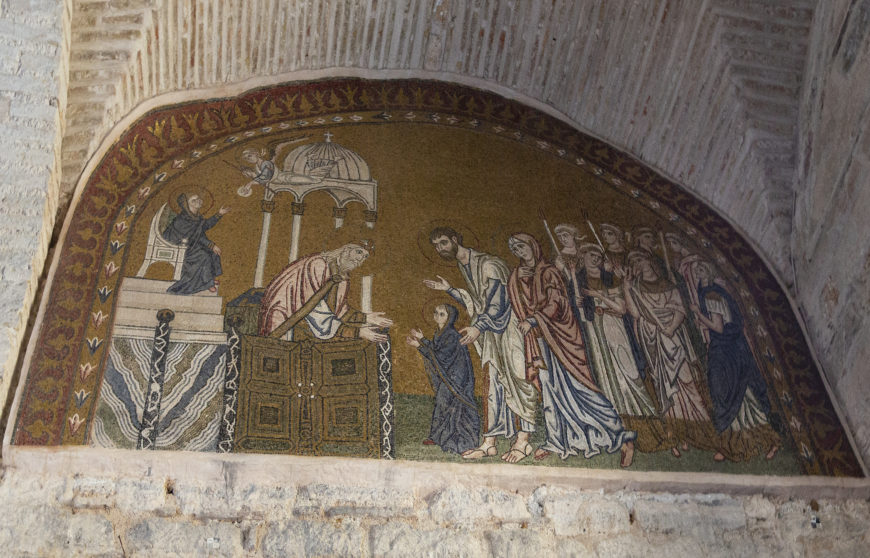
Presentation of the Virgin in the Temple mosaic, narthex, Daphni monastery, Chaidari, c. 1050–1150 (photo: Ariel Fein, CC BY-NC-SA 2.0)
Here, the narthex combines scenes from the lives of Christ and the Virgin, suggesting the church may have been dedicated to Mary. Notably, the Last Supper and Presentation of the Virgin in the Temple (where she was fed with heavenly bread by an angel) both appear on the eastern wall of the narthex, where worshippers would have seen them as they entered the church. Such images were meant to connect past events from sacred history with the celebration of the Eucharist in the present: Christ sharing bread and wine with his apostles at the Last Supper and Virgin eating heavenly bread in the temple were both understood to prefigure and symbolize the Eucharist. The appearance of the Foot Washing in the narthexes of all three of these churches may reflect the use of this part of the church for a ritual foot washing on Holy Thursday, when abbots imitated Christ by washing the feet of the monks.
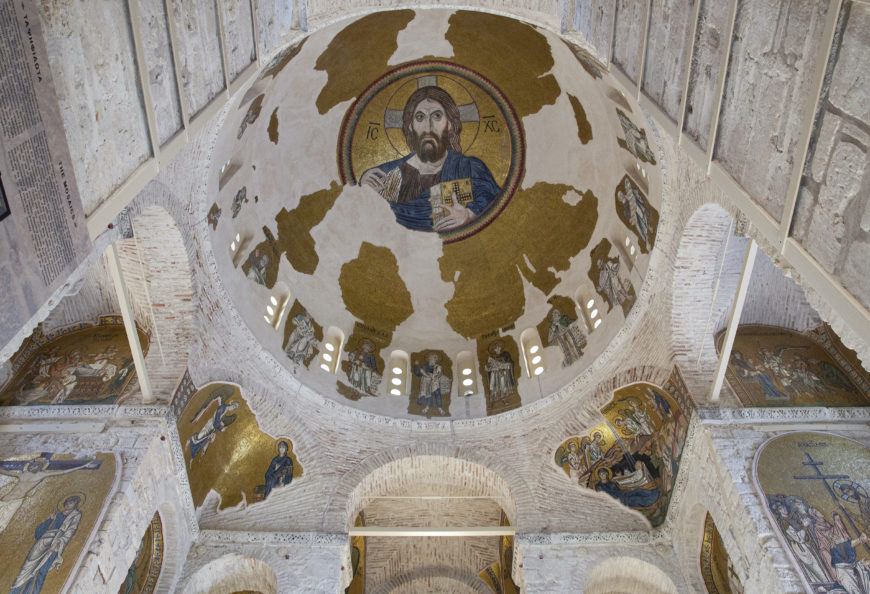
View of the naos looking east, Daphni monastery, Chaidari, c. 1050–1150 (photo: Ariel Fein, CC BY-NC-SA 2.0)
A monumental image of the heavenly Christ Pantokrator, framed by a rainbow mandorla in the central dome, dominates the naos. Photios interprets what must have been a similar image in the Pharos church as Christ reigning from the heavens:
You might say He is overseeing the earth, and devising its orderly arrangement and government, so accurately has the painter been inspired to represent, though only in forms and in colors, the Creator’s care for us. Photios of Constantinople, Homily 10
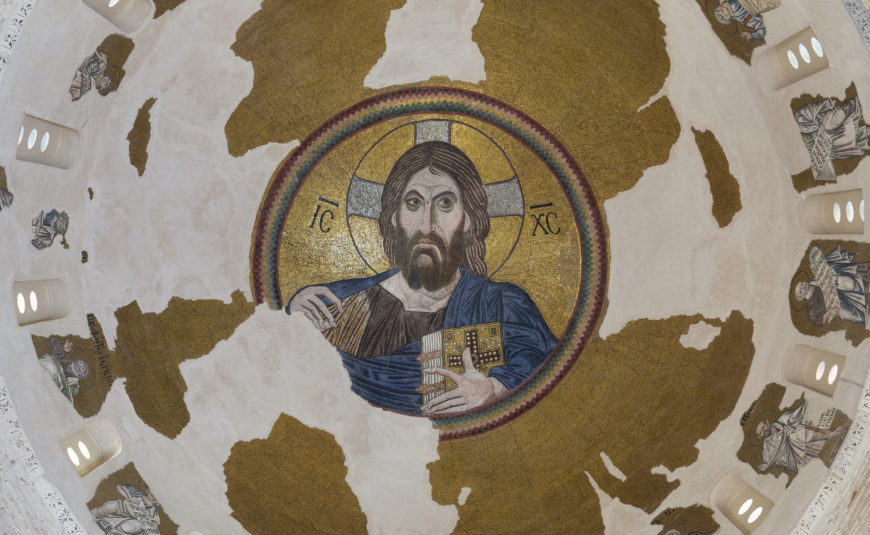
Christ Pantokrator mosaic, dome, Daphni monastery, Chaidari, c. 1050–1150 (photo: Ariel Fein, CC BY-NC-SA 2.0)
Scenes from the lives of Christ and the Virgin—such as the Annunciation—unfold in the squinches below and throughout the rest of the naos. The eastern apse reveals another Virgin and Child, and additional saints appear throughout the naos.
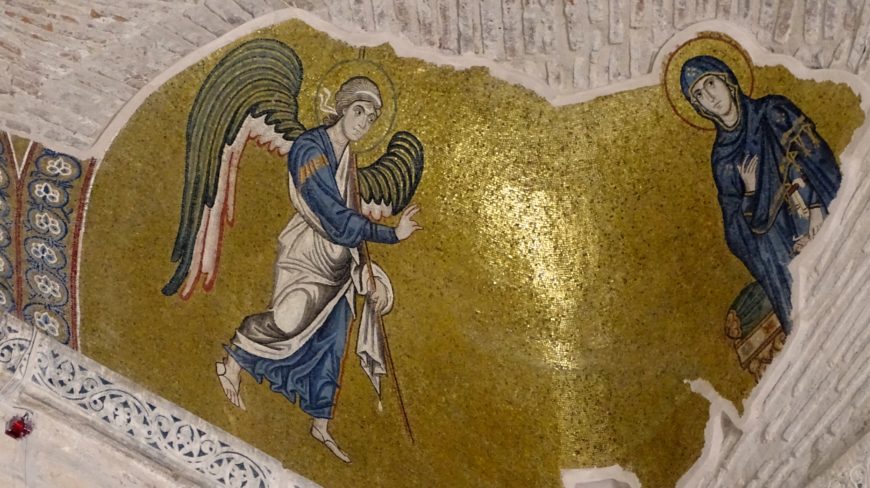
Annunciation mosaic, Daphni monastery, Chaidari, c. 1050–1150 (photo: Mark L. Darby, all rights reserved)
For worshippers entering these churches, mosaics offered a vision of God reigning from on high, a reminder of salvation history, and face-to-face encounters with so many saints who had come before. No wonder Photios found himself whirling around, trying to take in the overwhelming mosaics at the Pharos church, and feeling as if he had “entered heaven itself.”

